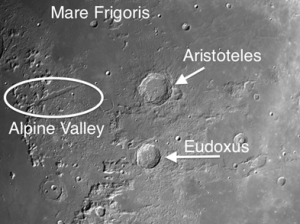The week of November 16-22 takes us from Lunar Day 2 to Day 8. This week we will highlight the crater Aristoteles, viewable on Saturday evening.
 Aristoteles1: [NE/D11] Close to the terminator Saturday evening there is an eye-catching pair of craters, Aristoteles and Eudoxus. Aristoteles is a complex crater with terraces, but in place of a central mountain it has a couple of small off-center peaks that are poking through the lava plain on its floor. The substantial ejecta blanket to the north of Aristoteles clearly shows radial structure, and if you catch it at lunar sunrise or sunset it will look like many points of light peeking through the shadows.
Aristoteles1: [NE/D11] Close to the terminator Saturday evening there is an eye-catching pair of craters, Aristoteles and Eudoxus. Aristoteles is a complex crater with terraces, but in place of a central mountain it has a couple of small off-center peaks that are poking through the lava plain on its floor. The substantial ejecta blanket to the north of Aristoteles clearly shows radial structure, and if you catch it at lunar sunrise or sunset it will look like many points of light peeking through the shadows.
Aristoteles adjoins the crater Mitchell to its immediate east. The pair violates the standard rule that smaller, younger craters are superimposed on top of larger, older craters. Can you tell that the younger (and larger) Aristoteles is intruding onto Mitchell (which is older and smaller)?
OF ADDITIONAL INTEREST IN SPACE:
Leonid meteor shower will happen on the night of Nov. 16-17. Look for the meteors between midnight and dawn–the best time will be around 1:00 a.m. The Leonids usually produce around 15 meteors per hour, but the Moon will be only a thin crescent, thus increasing the count, and the Leonids have been known to produce the most intense meteor storms in history. Sometimes, meteors have fallen at rates as high as 50,000 per hour!
The Leonid meteor shower happens every year in November, when Earth’s orbit crosses the orbit of Comet Tempel-Tuttle. The comet makes its way around the sun every 33.3 years, leaving a trail of dust rubble in its wake.
When Earth’s orbit crosses this trail of debris, pieces of the comet fall toward the planet’s surface. Air resistance in Earth’s atmosphere cause the comet’s crumbs to heat up and ignite into burning balls of fire called meteors.
1Aristotle: (384-322 BCE) Greek philosopher, student of Plato, and teacher of Alexander the Great. Because Aristotle believed that the circle was the “perfect” shape, he taught that the universe was spherical, finite, and centered on the Earth. But he also was one of the first scholars to teach that the Earth was round.
This was not based on a fanciful belief in the “perfection” of spheres, but on scientific evidence: He simply noticed that as one travelled north, the otherwise immovable North Star rose higher over the horizon. The only possible explanation was that the Earth was round. He also knew that lunar eclipses were caused by the shadow of the Earth, which was unmistakably curved.
======================
It is highly recommended that you get a copy of Sky and Telescope’s Field Map of the Moon, the very finest Moon map available for use at the telescope. It is available for $10.95 at www.skyandtelescope.com and on Amazon. All features mentioned in this blog will be keyed to the grid on the Field Map and will look like this: Plato: [NW/D9]
Credits:
Courtesy of Gray Photography of Corpus Christi, Texas
Lunar photos: NASA / USGS / BMDO / LROC / ASU / DLR / LOLA / Moon Globe. Used by permission
- Rupes Cauchy: A Best Known Fault on the Moon - July 22, 2024
- Moon Crater Schickard – Crater Floor has Stripes - July 15, 2024
- Moon Craters Langrenus and Vandelinus - July 8, 2024